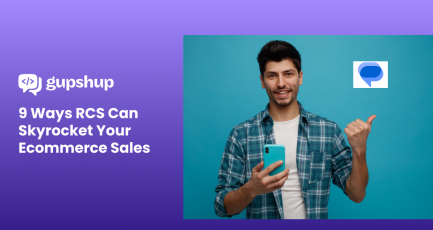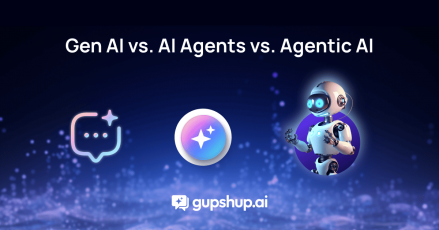Move beyond vanilla gamification; Immersive and Engaging Conversational Gamification is here

The earliest memory of a computer game for most people, particularly those born in the 80’s would probably be Prince of Persia or Super Mario. Since then, the world has been hooked to gaming. Among the fastest growing industries globally, today gaming is much more than just entertainment. Brands have taken core elements of gaming, to create user experiences that make their customers spend more time on apps. User engagement through gamification is a proven winner, inspiring more and more brands to make it a key part of their strategy.
According to a recent study by Insight Partners, the gamification market globally is expected to reach $62.75 billion by 2028, growing at a rate of 26.1% every year. As it is evident, corporations ranging from large to small are investing heavily in gamification. And while gamification on apps has existed for a while, conversational gamification is the latest approach to engaging users. With messaging apps being the primary channel for communication, conversational messaging led gamification works really well.
Why gamification appeals to deeper psychology
Before delving deeper into Conversational Gamification and how it can benefit your brand, it’s important to understand why gamification works.There is escapism of course but there are deeper psychological reactions that get triggered leading to a dopamine spike. Scoring points, reaching the next level or winning something–these aren’t mere actions. Games reinforce people’s innate need for status, accomplishment and fulfillment, making them more likely to develop a lasting relationship with a specific brand.

Gamification is increasingly being included into product design. By requiring users to perform tasks that align with their objectives and intrinsic motivations, addictive games keep people interested. If done right, it can be a powerful tool for maintaining user interest and building an enjoyable experience. Eventually, games help in creating a loyal set of users who keep coming back to the platform and end up becoming brand advocates.
Take for example- Starbucks. The brand is a great example of using gamification to improve customer experience resulting in higher sales. Customers receive “stars”- equivalent to points in the Starbucks ecosystem for each interaction with the app or transaction they make.
Depending on how loyal the players are, the game has different “levels.” Frequent visitors to the store are rewarded with upgraded levels.These include an additional cup of coffee, or even offers that are expressly made for the customer.
In addition to the psychological benefits of gamification, there are practical advantages for businesses too. For example, gamification can be used to gather valuable data and insights about customer behavior and preferences. By tracking user interactions and activities, companies can gain a better understanding of their audience and use this information to improve their products and services.
Brands that keep customer experience at the centre understand that there isn’t a better alternative for engagement than a gaming journey.
In his book, “Reality is broken: Why games make us better and how they can change the world”, Jane McGonigal says that in the engagement economy we are not competing for eyeballs or mindshare, rather we are competing for brain cycles and heart share.
“That’s why success in the new engagement economy won’t come from providing better or more competitive compensation. It will come from providing better and more competitive engagement—the kind of engagement that increases our personal and collective participation bandwidth by motivating us to do more, for longer, toward collective ends”, says McGonigal in one of the chapters.
Game, set and match with Conversational Gamification
Conversational Gamification certainly builds this motivation in a very interactive way. In the age of advertisement fatigue and cluttered social media feeds, conversation led gamification could act as the differentiator, hooking users. A highly engaged user base could help brands with credible word of mouth marketing, better brand recognition, lower customer acquisition costs and high loyalty.

Being conversational in nature, this kind of gamification is implemented through conversational interfaces, such as chatbots, WhatsApp Business API and voice assistants. There are several ways to gamify a conversational interface to increase user engagement. Here are a few examples:
- Points and rewards: By giving users points or rewards for completing certain actions or tasks, you can motivate them to continue interacting with the interface. For example, a chatbot could give users points for answering trivia questions correctly or for completing a survey. These points could then be redeemed for prizes or discounts.
- Leaderboards: By displaying a leaderboard of the top performers, you can create a sense of competition and encourage users to strive for the top spot. For example, a voice assistant could display a leaderboard of the users who have completed the most tasks in a week.
- Quests and challenges: By offering quests or challenges to users, you can create a sense of adventure and accomplishment. For example, a chatbot could offer users a series of tasks to complete in order to unlock new content or features.
- Personalization: By using data about users’ preferences and behaviors, you can create personalized experiences that are more engaging. For example, chatbots could recommend a sports OTT subscription to a user who engages with football quizzes.
- Awareness creation- The interactive format can be used to build awareness through participation in question & answers or short quizzes. Say a fitness startup wants to create awareness around healthy lifestyle. The app can gauge customer understanding and create awareness with a set of questions tailored around a healthy lifestyle.
Some real world examples of Conversational Gamification
Gupshup has worked with a number of brands to build user engagement through WhatsApp chatbots. WhatsApp works particularly well for building conversational gamification, given its popularity and high engagement rates.
With rich messaging features, quick replies and call to action buttons, WhatsApp Business API is perfectly suited to build a gamification experience through messaging. In these times of app fatigue, it’s important to build games on a channel where customers are, especially as in-app gamification is riddled with poor customer return cycles.
Here’s a brief snapshot of the work Gupshup has done in the conversational gamification space.
- India’s top radio station came up with a Cricket Jockey contest to connect with their listening audience.

- A leading TV channel launched a WhatsApp bot to engage with the audience of their most watched show. Viewers used the bot to participate in a daily poll. The poll helped audiences engage with the channel daily and share opinions on their favorite contestants in the show.
- One of the largest OTT platforms launched an interactive chatbot to boost brand engagement via stickers on WhatsApp. Customers could select genre and shows by chatting with the bot and could get stickers of popular characters from top trending shows and new releases. They (customers) could further use these stickers in peer conversations enhancing word of mouth recommendation for the OTT platform.
- A leading global sports organisation launched a WhatsApp bot where fans could choose between categories like stats, quizzes, fantasy teams and get the tournament schedule. Fans could also browse and shop for limited edition merchandise of their favorite teams and players.
- A leading TV channel launched a WhatsApp bot to engage with the audience of their most watched show. Viewers used the bot to participate in a daily poll. The poll helped audiences engage with the channel daily and share opinions on their favorite contestants in the show.
- A fintech company engaged opted-in users with a timeless cricket quiz. Customers could play the quiz by selecting from multiple choice answers. The CTA led them to the app to check and redeem rewards.

As it is quite clear from the examples above, incorporating gamification into conversational engagement can be a smart way for businesses to improve customer interactions and build stronger relationships with their audience. By offering rewards, fostering competition, and gathering valuable data, companies can create a more engaging and enjoyable user experience that keeps customers coming back for more. Give your brand the edge of conversational gamification and see your customers retain more. With Gupshup’s proven experience in WhatsApp marketing and conversational gamification, your brand can create desired outcomes effortlessly.




